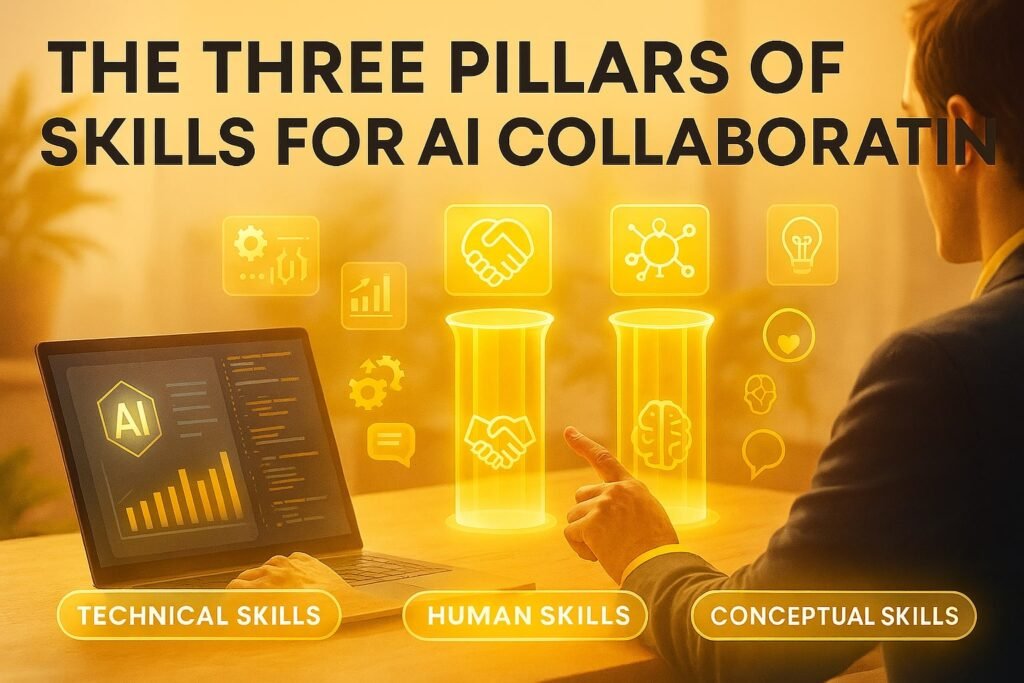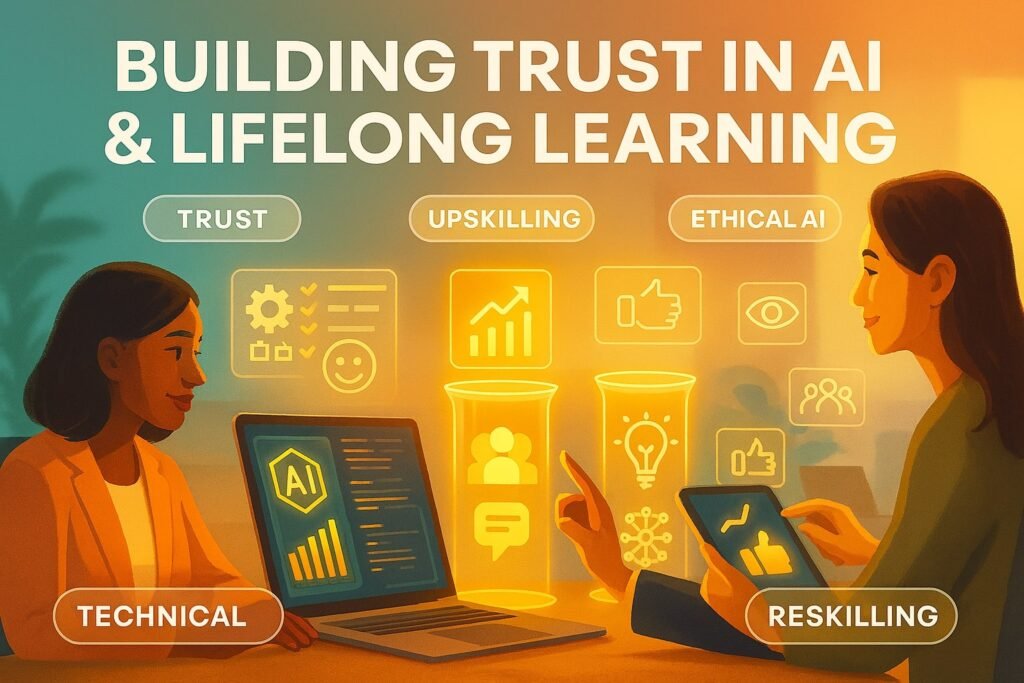Learning to work with Artificial Intelligence (AI) is no longer about the future—it is about today. The best way to see AI is not as a threat but as a tool and a partner. When you build a mix of skills—technical, human, and creative—you form a strong partnership with AI. This partnership can boost your work, save time, and open new paths for growth.
AI at work is changing how industries run. It takes over routine tasks and gives clear insights from data. This makes work faster and smarter. Yet, many people worry about jobs and the future of work. These are fair concerns. Still, if you learn to adapt, AI can become a career ally instead of a risk.
This guide shows you How to Work with Artificial Intelligence. You will learn:
- The skills you need to work side by side with AI.
- How to trust AI tools while staying in control.
- Why reskilling and upskilling are your best long-term strategies.
The most important step is to keep learning. AI will change fast, and the best way to stay ahead is to grow with it. With the right mindset, you can turn AI into a powerful partner in your work and future.
Understanding the New Normal: Worker-Artificial Intelligence Coexistence
The best way to learn how to work with artificial intelligence is to accept the idea of Worker-AI Coexistence. This is not about people fighting against machines. It is about teamwork, where each side uses its best skills.
AI is great at handling big sets of data, spotting patterns, and doing repeat tasks fast and with few errors. Humans bring other strengths—creativity, critical thought, and emotional intelligence. Together, they make a strong team.
A 2023 study in Technovation showed that the most successful workplaces use AI and people to support each other. AI takes care of the heavy number work. This gives humans more space for problem-solving, strategy, and building trust with customers. Think of AI as a smart helper that lifts you up, not as a rival trying to take your role.
My Experience with Using AI at Work
When I first added AI tools to my daily writing, I felt both excited and nervous. I worried that AI might weaken my own ideas. My aim was to use AI without losing my voice.
I began small. I asked an AI writing tool to make outlines and gather facts for me. I did not let it write the full piece. Instead, I used the output as a base. The AI pulled stats and built a clear flow in minutes. On my own, this would take hours. That gave me more time for the parts I love—telling stories, adding insights, and shaping the right tone for readers.
For one technical article, AI helped me replace hard jargon with simpler words. It also gave me new phrasing ideas to improve flow. In this way, the tool acted like an editor and a research buddy. With it, I was able to publish better work at a faster pace.
This taught me the key lesson of Worker-AI Coexistence: AI takes care of the “what,” while humans lead with the “why” and “how.”
What I Like / Strengths
- Increased Efficiency: AI can take over simple tasks like data checks or first drafts. This gives you more time for other work.
- Enhanced Creativity: With AI doing the boring parts, you have more mental space for big ideas.
- Data-Driven Decisions: AI spots trends and patterns fast, often faster than people.
- Personalized Learning: Many AI tools suggest training or skills that fit your needs.
Areas for Improvement
- Over-Reliance Risk: If you lean on AI too much, your own skills may fade.
- Lack of Context: AI does not always get company culture or human feelings.
- Building Trust: Many AI systems are a “black box.” To gain trust, firms must be open about how they use them.
The Three Pillars of Skills for AI Collaboration

To work well with AI, you need a mix of skills. Experts group them into three main areas. Each one matters, and they connect with each other.
1. Technical Skills: The Base of Interaction
Technical skills let you use and guide AI tools. You don’t need to be a coder or data scientist. But you should know how to run software, read dashboards, and use apps like chatbots or prediction tools.
For example:
- A marketer might use an AI-powered CRM to track customer trends.
- A logistics manager might use AI to plan faster delivery routes.
A McKinsey study shows that demand for tech skills may rise by 55% by 2030. That means reskilling and upskilling will be vital.
2. Human Skills: The Irreplaceable Part
Human skills—often called soft skills—are what people do best. These include:
- Clear communication
- Teamwork
- Empathy
- Leadership
In an AI-driven workplace, you will often work side by side with machines. But AI cannot replace human touch. It cannot lead a tough meeting, calm an angry client, or inspire a team. Emotional intelligence—the ability to read and guide feelings—is key to trust and teamwork.
These skills act as the glue that holds AI and people together.
3. Conceptual Skills: The Engine of Innovation
Conceptual skills are about critical and creative thought. They let you see the big picture and connect the dots.
AI can optimize tasks, but it cannot set bold new goals. Humans must ask the right questions, challenge results, and think outside the box.
For example:
The Modern Skillset: A Comparison
| Skill Category | Description | Examples in an AI Workplace |
| Technical Skills | Proficiency in using and managing technology and tools. | Using AI-powered analytics software, managing a CRM, basic coding, understanding machine learning concepts. |
| Human Skills | Interpersonal abilities for effective collaboration. | Communication, teamwork, leadership, empathy, negotiation, emotional intelligence. |
| Conceptual Skills | Abilities for abstract thinking and strategic problem-solving. | Critical thinking, creativity, strategic planning, data synthesis, innovation, decision-making. |
- AI may show a drop in sales.
- A person must ask why and design a smart new campaign to fix it.
These skills ensure we are not just users of AI. We are the ones who drive progress.
Building Trust in AI: The Key to a Symbiotic Relationship

One of the biggest challenges in Worker-AI Coexistence is trust. Many workers see AI as a threat to jobs or as a tool for constant surveillance. This fear often comes from the lack of clarity on how AI makes choices—the so-called “black box” problem.
To build real trust, organizations must take action:
- Transparency and Communication: Be clear about why an AI tool is being used, what it does, and how it helps. Show how it supports workers instead of replacing them. Be open about limits and risks.
- Ethical Frameworks: Use clear rules for fair and safe AI. This aligns with global goals like SDG 8, which promotes decent work. Staff need to know AI will not be unfair or biased.
- Human Oversight: Keep people in control. Important decisions should not rest only with AI. Let workers question or override AI outputs to protect human judgment.
- Inclusive Design: Involve employees when choosing or rolling out AI tools. When people help shape the systems they use, they trust them more.
A 2021 study on worker-AI trust found that employees trust AI more when they understand its purpose and feel in control. With trust, workers are more likely to share ideas, use AI to its full power, and grow with it.
Lifelong Learning: The Role of Reskilling and Upskilling
In the AI era, the only constant is change. Skills that matter today may be outdated tomorrow. The best way to stay ready is through lifelong learning. This means both upskilling and reskilling.
- Upskilling: Gaining new skills to do your current job better. Example: A graphic designer learns to use AI image tools to make quick drafts.
- Reskilling: Learning skills for a new role. Example: An office assistant whose tasks are automated may train to become a data analyst.
Organizations must support this shift. The World Economic Forum says over 50% of workers will need major retraining by 2025. Firms that invest in courses, on-the-job learning, and growth-friendly cultures will adapt faster.
For individuals, initiative is key. Look for online classes, certifications, and workshops in AI, data skills, and your field. This not only protects your career but also makes you a stronger asset for any employer.
FAQs How to Work with Artificial Intelligence
1. Will AI take my job?
AI will automate some tasks, mostly routine ones. But it is more likely to change jobs than replace them fully. AI does the simple work, leaving people free to focus on skills like creativity, strategy, and problem-solving.
2. What skills do I need for an AI-powered workplace?
You need a balanced skill set.
- Technical skills to use AI tools.
- Human skills like empathy and teamwork.
- Conceptual skills such as critical thinking and innovation.
3. How can I start learning to work with AI?
Start small. Try free AI tools in your field. Take online courses in data basics or AI. Most of all, stay curious and keep learning through upskilling and reskilling.
4. How do I build trust in AI if I don’t understand it?
Trust grows with clear communication. Ask your workplace how and why AI is used. Remember that humans should stay in control of key decisions. AI should be seen as a helper, not a replacement.
5. What is Worker-AI Coexistence?
It is a model where people and AI work together. AI boosts efficiency with data and routine tasks. Humans bring creativity, judgment, and emotional intelligence. Together, they create more value.
6. What is Sustainable Development Goal 8 (SDG 8) and how does it link to AI?
SDG 8 is a United Nations goal that promotes decent work and fair growth. In the AI era, this means using technology to create good jobs, protect workers, and share benefits fairly.
7. Do I need to learn coding to work with AI?
Not always. Coding is useful but not required. Many AI tools today are user-friendly and need no programming. What matters most is data literacy—the ability to read and explain data.
Conclusion
Learning to work with AI is a journey, not an end point. The rise of AI does not mean humans are obsolete. It means we must evolve. By embracing Worker-AI Coexistence, we can unlock new levels of productivity and creativity.
The way forward is clear:
- Build strong technical skills.
- Grow your human and conceptual skills.
- Commit to lifelong learning through reskilling and upskilling.
Trust in AI will grow with transparency and ethics. With this, AI can align with SDG 8 and help create a future of fair, meaningful, and productive work.
Are you ready to take the next step? Start with one small task in your daily work. Use an AI tool to make it easier. That first step is the start of your journey toward true collaboration with AI.
About the Author
Araz Zirar is a researcher and expert in the intersection of technology, human resources, and organizational strategy. With a focus on the practical implications of Artificial Intelligence (AI) in the modern workplace, his work explores how organizations can foster a collaborative environment where both workers and technology thrive. His insights are drawn from extensive academic research and real-world case studies on digital transformation.
References
- Zirar, A., Ali, S. I., & Islam, N. (2023). “Worker and workplace Artificial Intelligence (AI) coexistence: Emerging themes and research agenda.” Technovation, 124, 102747.
- McKinsey Global Institute. (2018). “Skill shift: Automation and the future of the workforce.”
- World Economic Forum. (2020). “The Future of Jobs Report 2020.”
- Organisation for Economic Co-operation and Development (OECD). (2021). “AI Principles.”


